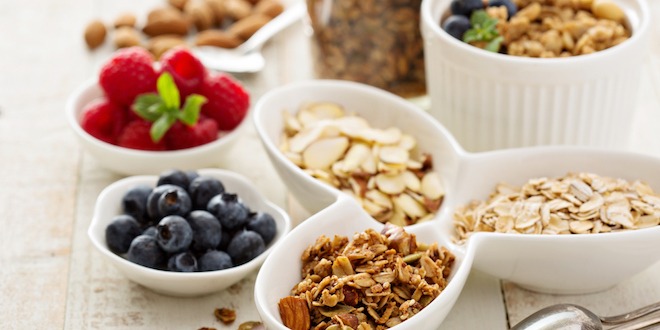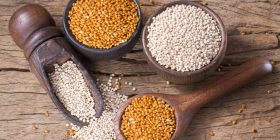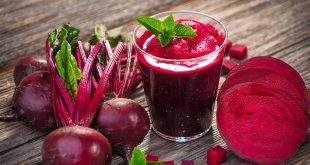Most Canadians don't get enough fibre in their diet. Learn how you can change that!
What is fibre?
Fibre is a type of carbohydrate that passes through your digestive system without being digested. One of the most important benefits of fibre is that it helps food to move efficiently through your body. But that’s not the only job that fibre does. It also:
- Aids in the prevention of heart disease by helping lower your cholesterol
- Helps control blood sugar in people with diabetes
- Helps with weight loss (high-fibre foods are lower in calories, so they tend to make you feel full)
What foods contain fibre?
- Legumes (navy beans, kidney beans, soybeans)
- Grains (bran, oats, rye and barley)
- Some fruits, such as figs, avocados, plums, prunes, bananas, apples and pears
- Berries, including raspberries, blackberries and strawberries
- Vegetables, such as broccoli, carrots, green beans, cauliflower, zucchini and celery
- Root vegetables, such as potatoes, sweet potatoes and onions
- Nuts, such as almonds, pecans or walnuts (these have more fibre than other nuts)
- Flax seeds and chia seeds
- Whole grain breads and pastas
- Some probiotic yogurts, which have added fibre
How much fibre should I have?
The Diabetes Canada clinical practice guidelines recommend that adults with diabetes should consume 25 to 50 grams of fibre every day. Unfortunately, Health Canada estimates that most Canadians are only getting about half the recommended about of fibre per day. Check out the chart below to see if you are getting enough.
How can I increase fibre in my diet?
Check out the tips below for some handy ways that you can incorporate fibre into your daily diet.
Fruits and vegetables
- Choose whole vegetables and fruits instead of juice.
- Use fresh or frozen vegetables in a stir-fry or a casserole
- Wash the skins of fruits and vegetables instead of peeling them – the peel often contains fibre
- Add fresh or frozen berries to cereal and yogurt
- Add dried or fresh fruit to yogurt, salads and homemade muffins
- Top yogurt with berries or diced fresh fruit
Grains
- Choose whole grain breads that have at least 2 grams of fibre per slice
- Start your day with a high-fibre cereal that has 4 grams of fibre per serving
- Crush bran cereal and add it to pancakes, cookies, muffins and breads
- Use whole grain wheat flour instead of white flour when baking bread
- Use whole wheat pasta or brown rice instead of white pasta or white rice
Legumes
- Boost the fibre content of chili or stew by replacing half the meat with chickpeas, cannellini beans, black beans or kidney beans
- Add lentils or soybeans to soups or casseroles
- For a quick lunch or snack, spread hummus on whole grain flat bread
Nuts and seeds
- Add ground flax seeds or chia seeds to cereal or porridge
- Prepare a mixture of almonds, sunflower seeds and pine nuts, and enjoy a small handful as a snack
- Add hazelnuts or walnuts to baked muffins
- Top yogurt with nuts and seeds
So, what foods contain fibre – and how much? Check out the handy table below, which lists the fibre content of various foods groups.* (Check the Nutrition Facts Table on packaged foods for the exact amount of the fibre content of the foods you’re consuming.)
| Food | Amount | Fibre content |
| Vegetables (cooked) | ||
| Artichoke | 1 medium | 10 grams |
| Beans (green or yellow) | ½ cup | 1.5 grams |
| Broccoli | ½ cup | 2.0 to 2.5 grams |
| Brussels sprouts | ½ cup | 3 grams |
| Carrots | ½ cup | 2 grams |
| Cauliflower | ½ cup | 1.5 to 2.5 grams |
| Collards or turnip greens | ½ cup | 4 grams |
| Corn | ½ cup | 2 grams |
| Green peas | ½ cup | 4 to 5 grams |
| Lima beans | ½ cup | 5 grams |
| Parsnips | ½ cup | 3 grams |
| Potato, with skin | 1 medium | 3 to 4 grams |
| Spinach | ½ cup | 3 grams |
| Squash (acorn or butternut) | ½ cup | 2 grams |
| Sweet potato | 1 medium | 4 grams |
| Fruit | ||
| Apple, with skin | 1 medium | 3.5 grams |
| Apricots, fresh or dried | 3 | 1.5-2 grams |
| Avocado | ½ | 7 grams |
| Banana | 1 medium | 2 grams |
| Cherries | 20 | 3.5 grams |
| Grapefruit | ½ | 2.5 grams |
| Guava | 1 fruit | 5 grams |
| Kiwi fruit | 1 large | 2.5 grams |
| Nectarine | 1 medium | 2.5 grams |
| Orange | 1 medium | 2.5 grams |
| Peach | 1 medium | 3 grams |
| Pear, with skin | 1 medium | 5 grams |
| Plums | 2 | 2 grams |
| Prunes, dried or cooked | ¼ cup | 3.5 grams |
| Raspberries or blackberries | ½ cup | 4 grams |
| Grain products | ||
| Barley, cooked | ½ cup | 2 grams |
| Bran flakes | 1 cup | 8 grams |
| Bread (rye) | 1 slice | 1.5 grams |
| Bread (whole wheat, pumpernickel) | 1 slice | 2 grams |
| English muffin, whole wheat | ½ | 2 grams |
| Oatmeal, cooked | 1 cup | 4 grams |
| Pasta, spinach, cooked | ½ cup | 2.5 grams |
| Pasta, white, cooked | ½ cup | 1 gram |
| Pasta, whole wheat, cooked | ½ cup | 2.5 grams |
| Pita, whole wheat | ½ | 2.5 grams |
| Popcorn, air popped | 2 cups | 2.5 grams |
| Rice (brown or wild), cooked | ½ cup | 2 grams |
| Legumes | ||
| Baked beans | ¾ cup | 8 to 10 grams |
| Beans (white, yellow, black, pinto, kidney, navy, cooked | ¾ cup | 9 to 14 grams |
| Chickpeas, cooked | ¾ cup | 5 grams |
| Hummus | ¼ cup | 4 grams |
| Lentils, cooked | ¾ cup | 6 grams |
| Peas (black-eyed, pigeon), cooked | ¾ cup | 8 grams |
| Soybeans, mature, cooked | ¾ cup | 8 grams |
| Nuts and seeds | ||
| Almonds, whole | ¼ cup | 4 grams |
| Coconut meat, dried, shredded | ½ cup | 8 grams |
| Flax seeds, whole or ground | 1 tablespoon | 3 grams |
| Nuts (hazelnuts, macadamia, pistachio) | ¼ cup | 3 to 3.5 grams |
| Pumpkin or squash seeds | ¼ cup | 4 grams |
| Soy nuts, roasted | ¼ cup | 2 grams |
| Sunflower seeds, without shell | ¼ cup | 4 grams |
*This table was adapted from Dietitians of Canada.
 Diabetes Care Community Learn, connect and care
Diabetes Care Community Learn, connect and care






One comment
Pingback: Managing high blood sugar with type 1 diabetes - Diabetes Care Community